Effects of Laser Mutagenesis on Microalgae Production and Lipid Accumulation in Two Economically Important Fresh Chlorella Strains under Heterotrophic Conditions
Abstract
1. Introduction
2. Materials and Methods
2.1. Microalgae Culture
2.2. Laser Irradiation
2.3. Determination of Mortality Content and Biomass
2.4. Determination of Total Lipid Content and Lipid Productivity
2.5. Analysis of High-Value Polyunsaturated Fatty Acids
2.6. Statistical Analysis
3. Results
3.1. Screening Laser Mutants of FACHB 9 and FACHB 31
3.2. Heterotrophic Growth of FACHB 9 and FACHB 31 Laser Mutants
3.3. Measurement of Biomass of Laser Mutants of FACHB 9 and FACHB 31
3.4. Determination of Lipid Content in Laser Mutants of FACHB 9 and FACHB 31
3.5. Determination of Lipid Productivity in Laser Mutants of FACHB 9 and FACHB 31
3.6. Fatty Acids of FACHB 9 and FACHB 31 Mutants
4. Discussion
4.1. Effects of Laser Mutagenesis on Biomass and Lipid Contents in FACHB 9 and FACHB 31
4.2. Effects of Heterotrophic Cultivation on Biomass and Lipid Contents of FACHB 9 and FACHB 31
4.3. Effects of Laser Mutagenesis and Heterotrophic Cultivation on the Accumulation of Fatty Acids in FACHB 9 and FACHB 31
5. Conclusions
Author Contributions
Funding
Conflicts of Interest
References
- Bajpai, P. Current Trends and the Future of the Algae-Based biofuels industry. In Third Generation Biofuels; SpringerBriefs in Energy; Springer: Singapore, 2019; pp. 67–70. [Google Scholar]
- Collotta, M.; Champagne, P.; Mabee, W.; Tomasoni, G.; Alberti, M. Life cycle analysis of the production of biodiesel from microalgae. In Life Cycle Assessment of Energy Systems and Sustainable Energy Technologies: Green Energy and Technology; Basosi, R., Cellura, M., Longo, S., Parisi, M., Eds.; Springer: Cham, Switzerland, 2018; pp. 155–169. [Google Scholar]
- Rosenberg, J.N.; Oyler, G.A.; Wilkinson, L.; Betenbaugh, M.J. A green light for engineered algae: Redirecting metabolism to fuel a biotechnology revolution. Curr. Opin. Biotechnol. 2008, 19, 430–436. [Google Scholar] [CrossRef] [PubMed]
- Li, S.H.; Ji, L.; Shi, Q.W.; Wu, H.Z.; Fan, J.H. Advances in the production of bioactive substances from marine unicellular microalgae Porphyridium spp. Bioresour. Technol. 2019, 292, 122048. [Google Scholar] [CrossRef] [PubMed]
- Wan, M.X.; Liu, P.; Xia, J.L.; Rosenberg, J.N.; Oyler, G.A.; Betenbaugh, M.J.; Nie, Z.Y.; Qiu, G.Z. The effect of mixotrophy on microalgal growth, lipid content, and expression levels of three pathway genes in Chlorella sorokiniana. Appl. Microbiol. Biotechnol. 2011, 91, 835–844. [Google Scholar] [CrossRef] [PubMed]
- Suparmaniam, U.; Lam, M.K.; Uemura, Y.; Lim, J.W.; Lee, K.T.; Shuit, S.H. Insights into the microalgae cultivation technology and harvesting process for biofuel production: A review. Renew. Sustain. Energy Rev. 2019, 115, 109361. [Google Scholar] [CrossRef]
- Jacob-Lopes, E.; Queiroz Zepka, L.; Queiroz, M. Energy from Microalgae. In Green Energy and Technology; Biofuels from Microalgae: Biodiesel; Reijnders, L., Ed.; Springer: Cham, Switzerland, 2018; pp. 171–180. [Google Scholar]
- Hsieh, H.J.; Su, C.H.; Chien, L.J. Accumulation of lipid production in Chlorella minutissima by triacylglycerol biosynthesis-related genes cloned from Saccharomyces cerevisiae and Yarrowia lipolytica. J. Microbiol. 2012, 50, 526–534. [Google Scholar] [CrossRef]
- Talebi, A.F.; Tohidfar, M.; Tabatabaei, M.; Bagheri, A.; Mohsenpor, M.; Mohtashami, S.K. Genetic manipulation, a feasible tool to enhance unique characteristic of Chlorella vulgaris as a feedstock for biodiesel production. Mol. Biol. Rep. 2013, 40, 4421–4428. [Google Scholar] [CrossRef]
- Du, H.M.; Ahmed, F.; Lin, B.; Li, Z.; Huang, Y.H.; Sun, G.; Ding, H.; Wang, C.; Meng, C.X.; Gao, Z.Q. The effects of plant growth regulators on cell growth, protein, carotenoid, PUFAs and lipid production of C. pyrenoidosa ZF strain. Energies 2017, 10, 1696. [Google Scholar] [CrossRef]
- Lin, B.; Ahmed, F.; Du, H.M.; Li, Z.M.; Yan, Y.C.; Huang, Y.H.; Cui, M.; Yin, Y.H.; Li, B.; Wang, M.M.; et al. Plant growth regulators promote lipid and carotenoid accumulation in Chlorella vulgaris. J. Appl. Phycol. 2018, 30, 1549–1561. [Google Scholar] [CrossRef]
- Ma, F.X.; Chen, X.Y. Laser applications in seed germination, mutation breeding and gene engineering for forestry and horticulture. Physics 2007, 36, 637–642. [Google Scholar]
- Liu, S.; Zhao, Y.; Liu, L.; Ao, X.; Ma, L.; Wu, M.; Ma, F. Improving Cell Growth and Lipid Accumulation in Green Microalgae Chlorella sp. via UV Irradiation. Appl. Biochem. Biotechnol. 2015, 175, 3507–3518. [Google Scholar] [CrossRef]
- Ouf, S.A.; Alsarrani, A.Q.; Al-Adly, A.A.; Ibrahim, M.K. Evaluation of low-intensity laser radiation on stimulating the cholesterol degrading activity: Part, I. Microorganisms isolated from cholesterol-rich materials. Saudi J. Biol. Sci. 2012, 19, 185–193. [Google Scholar] [CrossRef]
- Smith, V.H.; Sturm, B.S.M.; Denoyelles, F.G.; Billings, S.A. The ecology of algal biodiesel production. Trends Ecol. Evol. 2010, 25, 301–309. [Google Scholar] [CrossRef]
- Zhang, H.N.; Gao, Z.Q.; Li, Z.; Du, H.M.; Lin, B.; Cui, M.; Yin, Y.H.; Lei, F.M.; Yu, C.Y.; Meng, C.X. Laser Radiation Induces Growth and Lipid Accumulation in the Seawater Microalga Chlorella pacifica. Energies 2017, 10, 1671. [Google Scholar] [CrossRef]
- Kishi, M.; Kawai, M.; Toda, T. Heterotrophic utilization of ethylene glycol and propylene glycol by Chlorella protothecoides. Algal Res. 2015, 11, 428–434. [Google Scholar] [CrossRef]
- Wu, G.X.; Gao, Z.Q.; Du, H.M.; Lin, B.; Yan, Y.C.; Li, G.Q.; Guo, Y.Y.; Fu, S.G.; Wei, G.X.; Wang, M.M.; et al. The effects of abscisic acid, salicylic acid and jasmonic acid on lipid accumulation in two freshwater Chlorella strains. J. Gen. Appl. Microb. 2018, 64, 42–49. [Google Scholar] [CrossRef]
- Perez-Garcia, O.; Escalante, F.M.E.; De-Bashan, E.L.; Bashan, Y. Heterotrophic cultures of microalgae: Metabolism and potential products. Water Res. 2011, 45, 11–36. [Google Scholar] [CrossRef]
- Xie, T.H.; Xia, Y.; Zeng, Y.; Li, X.R.; Zhang, Y.K. Nitrate concentration-shift cultivation to enhance protein content of heterotrophic microalga Chlorella vulgaris: Over-compensation strategy. Bioresour. Technol. 2017, 233, 247–255. [Google Scholar] [CrossRef]
- Miao, X.L.; Wu, Q.Y. Biodiesel production from heterotrophic microalgal oil. Bioresour. Technol. 2006, 97, 841–846. [Google Scholar] [CrossRef]
- Patel, A.K.; Singhania, R.R.; Sim, S.J.; Cheng, D.D. Recent advancements in mixotrophic bioprocessing for production of high value microalgal products. Bioresour. Technol. 2021, 320 Pt B, 124421. [Google Scholar] [CrossRef]
- Chi, Z.Y.; Zheng, Y.B.; Ma, J.W.; Chen, S.L. Oleaginous yeast Cryptococcus curvatus culture with dark fermentation hydrogen production effluent as feedstock for microbial lipid production. Int. J. Hydrogen Energy 2011, 36, 9542–9550. [Google Scholar] [CrossRef]
- Azma, M.; Mohamed, M.S.; Mohamad, R.; Rahim, R.A.; Arif, A.B. Improvement of medium composition for heterotrophic cultivation of green microalgae Tetraselmis suecica, using response surface methodology. Biochem. Eng. J. 2011, 53, 187–195. [Google Scholar] [CrossRef]
- Samek, O.; Zemanek, P.; Jona, A.; Telle, H.H. Characterization of oil-producing microalgae using Raman spectroscopy. Laser Phys. Lett. 2011, 8, 701–709. [Google Scholar] [CrossRef]
- Bligh, E.G.; Dyer, W.J. A rapid method of total lipid extraction and purification. Canad. J. Physiol. Pharm. 1959, 37, 911–917. [Google Scholar]
- Cha, T.S.; Chen, J.W.; Goh, E.G.; Aziz, A.; Loh, S.H. Differential regulation of fatty acid biosynthesis in two Chlorella species in response to nitrate treatments and the potential of binary blending microalgae oils for biodiesel application. Bioresour. Technol. 2011, 102, 10633–10640. [Google Scholar] [CrossRef]
- White, B. Dietary fatty acids. Am. Fam. Phys. 2009, 80, 345–350. [Google Scholar]
- Kim, S.H.; Lim, S.R.; Hong, S.J.; Cho, B.K.; Lee, H.; Lee, C.G.; Choi, H.K. Effect of ethephon as an ethylene-releasing compound on the metabolic profile of Chlorella vulgaris. J. Agric. Food Chem. 2016, 64, 4807–4816. [Google Scholar] [CrossRef]
- Bilian, C.; Huiru, Z.; Mingzi, W.; Rong, C. Mutagenesis of Spirulina platensis by Nd:YAG laser. Acta Laser Biol. Sin. 2000, 9, 125–128. [Google Scholar]
- Zhao, M.M.; Wang, W.W. Studies on the mutagenesis of Spirulina platensis using He-Ne laser. Acta Photonica Sin. 2005, 34, 400. [Google Scholar]
- Bilian, C.; Mingzi, W.; Huiru, Z.; Rong, C. Effects of LD laser on the growth and morphology of Spirulina platensis. Acta Photonica Sin. 2000, 29, 411. [Google Scholar]
- Muthuraj, M.; Selvaraj, B.; Palabhanvi, B.; Kumar, V.; Das, D. Enhanced lipid content in chlorella sp. FC2 IITG via high energy irradiation mutagenesis. Korean J. Chem. Eng. 2018, 36, 63–70. [Google Scholar] [CrossRef]
- Rahman, D.Y.; Rachmayati, R.; Widyaningrum, D.N.; Susilaningsih, D. Enhancement of lipid production of chlorella sp. 042 by mutagenesis. IOP Conf. Ser. Earth Environ. Sci. 2020, 439, 012021. [Google Scholar] [CrossRef]
- Eriksen, N.T. The technology of microalgal culturing. Biotechnol. Lett. 2008, 30, 1525–1536. [Google Scholar] [CrossRef] [PubMed]
- Marudhupandi, T. Heterotrophic cultivation of Nannochloropsis salina for enhancing biomass and lipid production. Biotechnol. Rep. 2016, 10, 8–16. [Google Scholar] [CrossRef] [PubMed]
- Fang, X.; Wei, C.; Zhao, L.C.; Fan, O.Y. Effects of organic carbon sources on cell growth and eicosapentaenoic acid content of Nannochloropsis sp. J. Appl. Phycol. 2004, 16, 499–503. [Google Scholar] [CrossRef]
- Shi, X.M.; Liu, H.J.; Zhang, X.W.; Chen, F. Production of biomass and lutein by Chlorella protothecoides at various glucose concentrations in heterotrophic cultures. Proc. Biochem. 1999, 34, 341–347. [Google Scholar] [CrossRef]
- Xiong, W.; Li, X.F.; Xiang, J.Y.; Wu, Q.Y. High-density fermentation of microalga Chlorella protothecoides in bioreactor for microbio-diesel production. Appl. Microbiol. Biotechnol. 2008, 78, 29–36. [Google Scholar] [CrossRef]
- Xu, H.; Miao, X.; Wu, Q. High quality biodiesel production from a microalga chlorella protothecoides by heterotrophic growth in fermenters. J. Biotechnol. 2006, 126, 499–507. [Google Scholar] [CrossRef]
- Swaaf, M.E.D.; Pronk, J.T.; Sijtsma, L. Fed-batch cultivation of the docosahexaenoic- acid-producing marine alga Crypthecodinium cohnii on ethanol. Appl. Microbiol. Biotechnol. 2003, 61, 40–43. [Google Scholar] [CrossRef]
- Jin, L.; Huang, J.; Zheng, S.; Zhong, Y.; Yue, J.; Feng, C. Differential lipid and fatty acid profiles of photoautotrophic and heterotrophic Chlorella zofingiensis: Assessment of algal oils for biodiesel production. Bioresour. Technol. 2011, 102, 106–110. [Google Scholar]
- Campos, H.; Boeing, W.J.; Dungan, B.N.; Schaup, T. Cultivating the marine microalga Nannochloropsis salina under various nitrogen sources: Effect on biovolume yields, lipid content and composition, and invasive organism. Biomass Bioenergy 2014, 66, 301–307. [Google Scholar] [CrossRef]
- Takatsuka, Y.; Yamaguchi, Y.; Ono, M.; Kamio, Y. Gene cloning and molecular characterization of lysine decarboxylase from selenomonas ruminantium delineate its evolutionary relationship to ornithine decarboxylases from eukaryotes. J. Bacteriol. 2000, 182, 6732–6741. [Google Scholar] [CrossRef][Green Version]
- Mahan, S.D.; Ireton, G.C.; Stoddard, B.L.; Black, M.E. Alanine-scanning mutagenesis reveals a cytosine deaminase mutant with altered substrate preference. Biochemistry 2004, 43, 8957–8964. [Google Scholar] [CrossRef]
- Huang, R.; Hippauf, F.; Rohrbeck, D.; Haustein, M.; Wenke, K.; Feike, J.; Barkman, T.J. Enzyme functional evolution through improved catalysis of ancestrally nonpreferred substrates. Proc. Natl. Acad. Sci. USA 2012, 109, 2966–2971. [Google Scholar] [CrossRef]
- Muthuraj, M.; Kumar, V.; Palabhanvi, B.; Das, D. Evaluation of indigenous microalgal isolate Chlorella sp. FC2 IITG as a cell factory for biodiesel production and scale up in outdoor conditions. J. Ind. Microbiol. Biotechnol. 2014, 41, 499–511. [Google Scholar] [CrossRef]
- Anthony, J.; Rangamaran, V.R.; Gopal, D.; Shivasankarasubbiah, K.T.; Thilagam, M.; Dhassiah, M.P. Ultraviolet and 5′ fluorodeoxyuridine induced random mutagenesis in chlorella vulgaris and its impact on fatty acid profile: A new insight on lipid-metabolizing genes and structural characterization of related proteins. Mar. Biotechnol. 2015, 17, 66–80. [Google Scholar] [CrossRef]

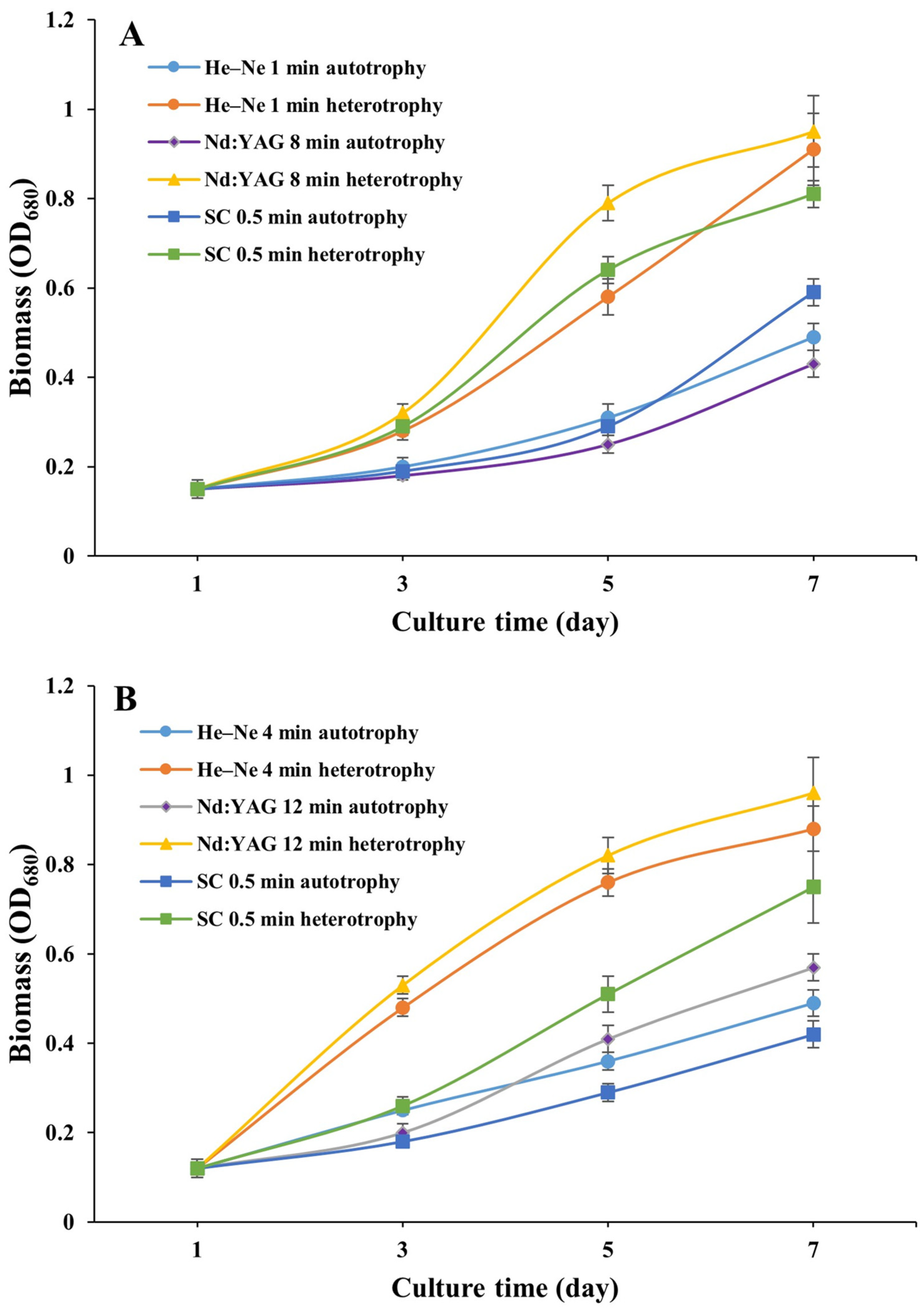
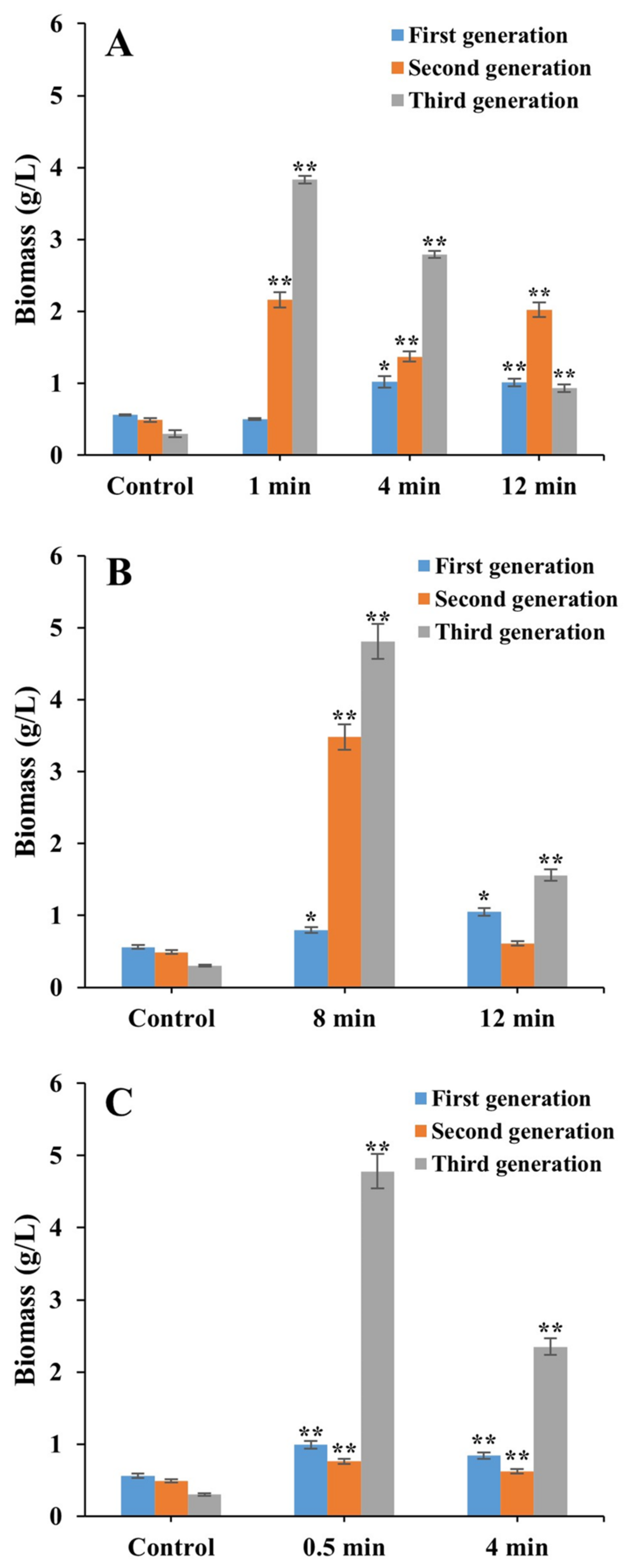
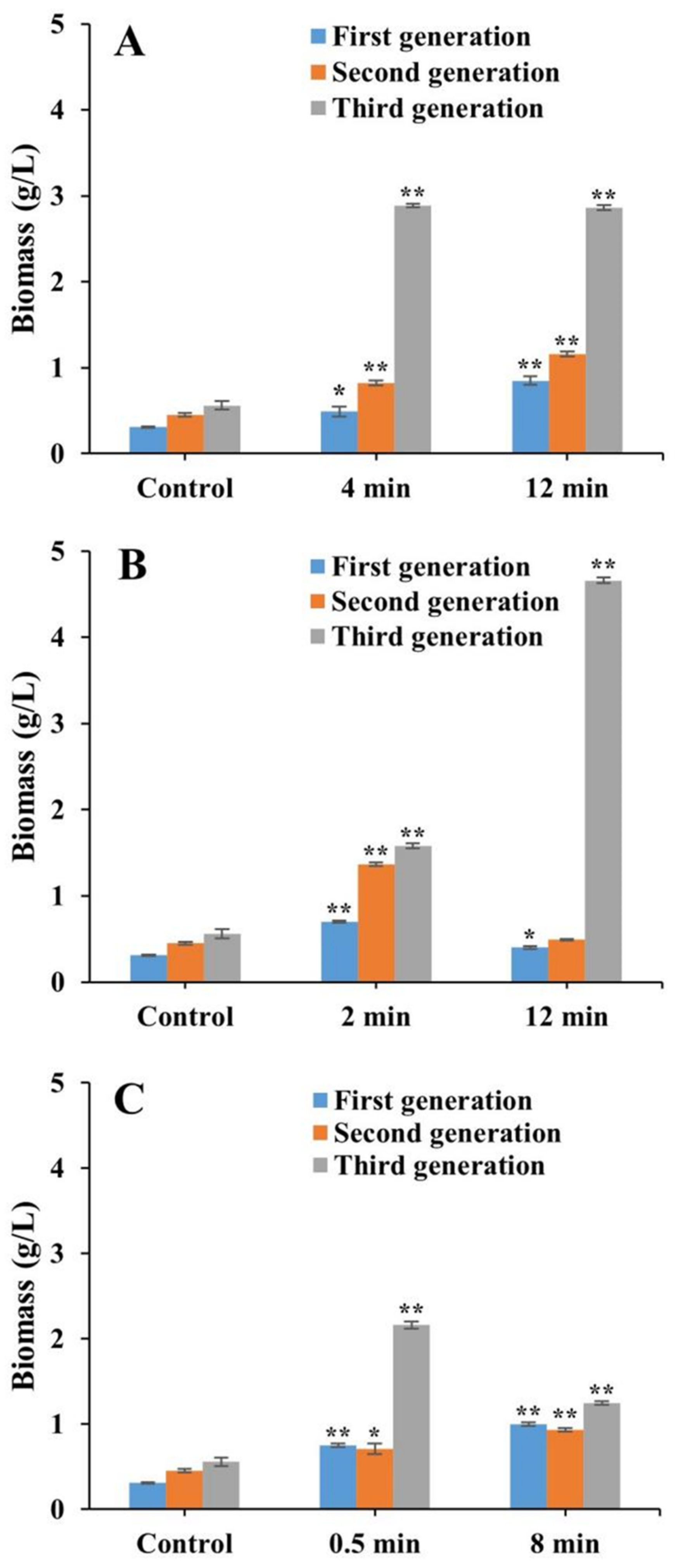
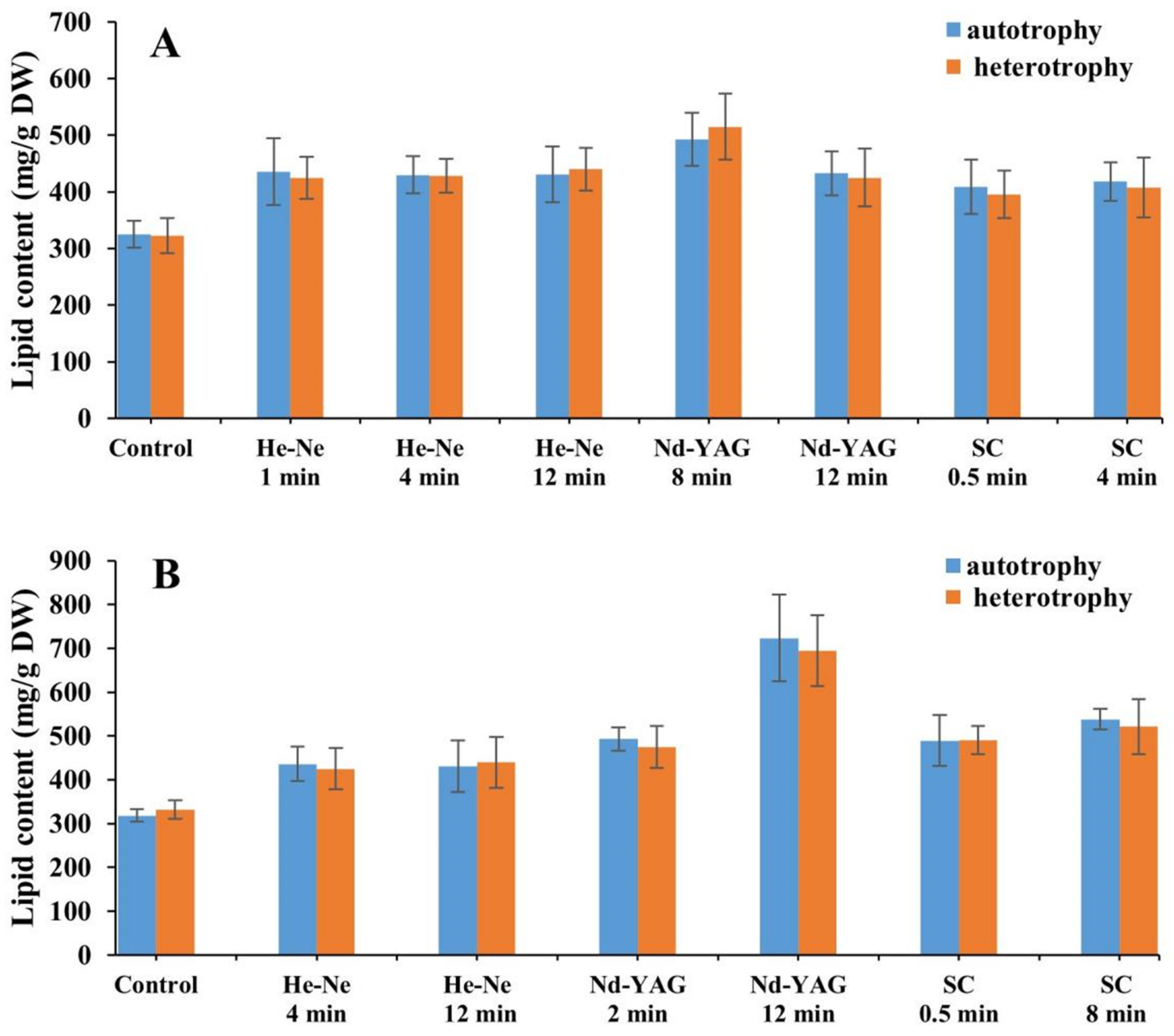
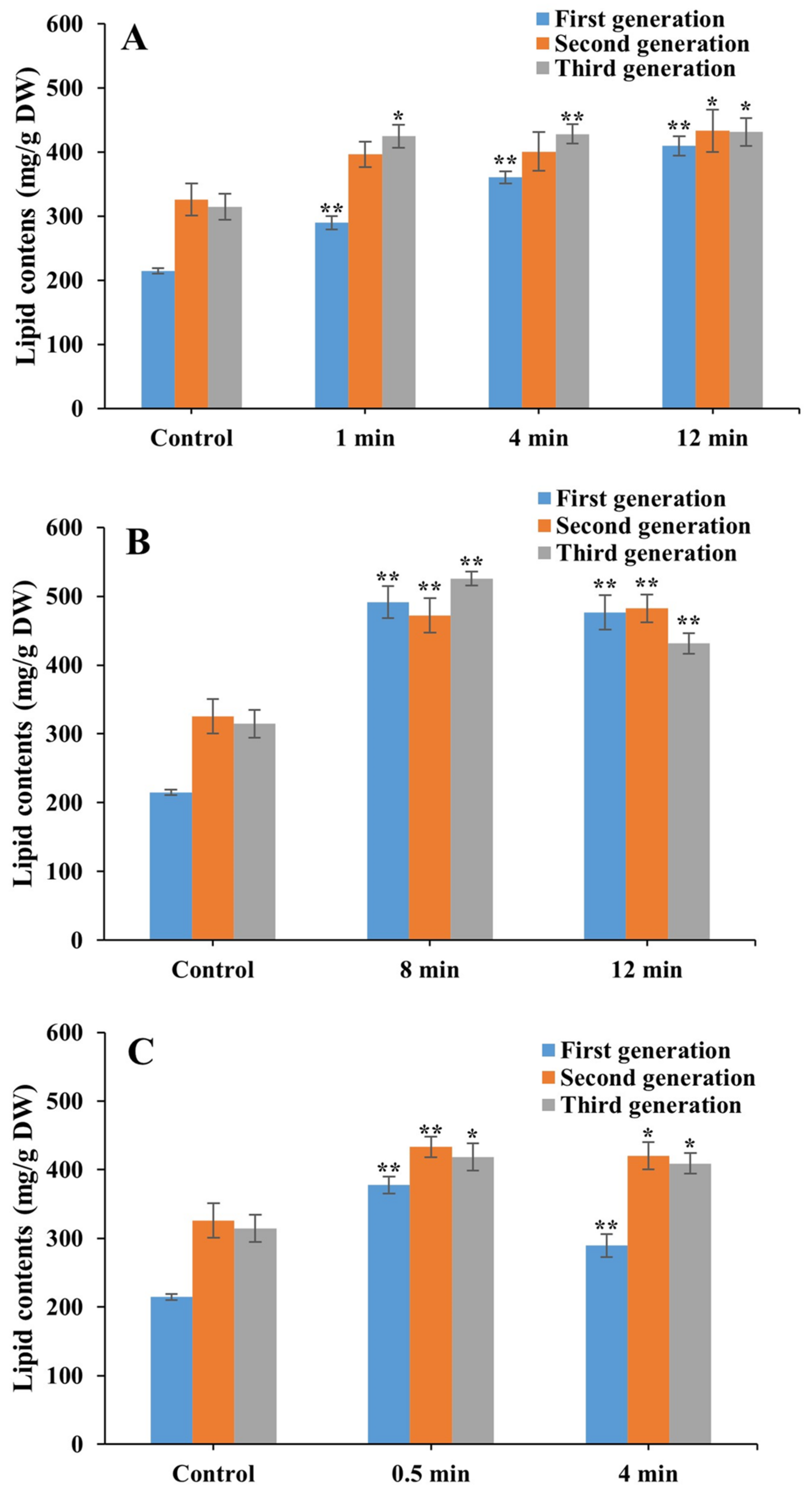
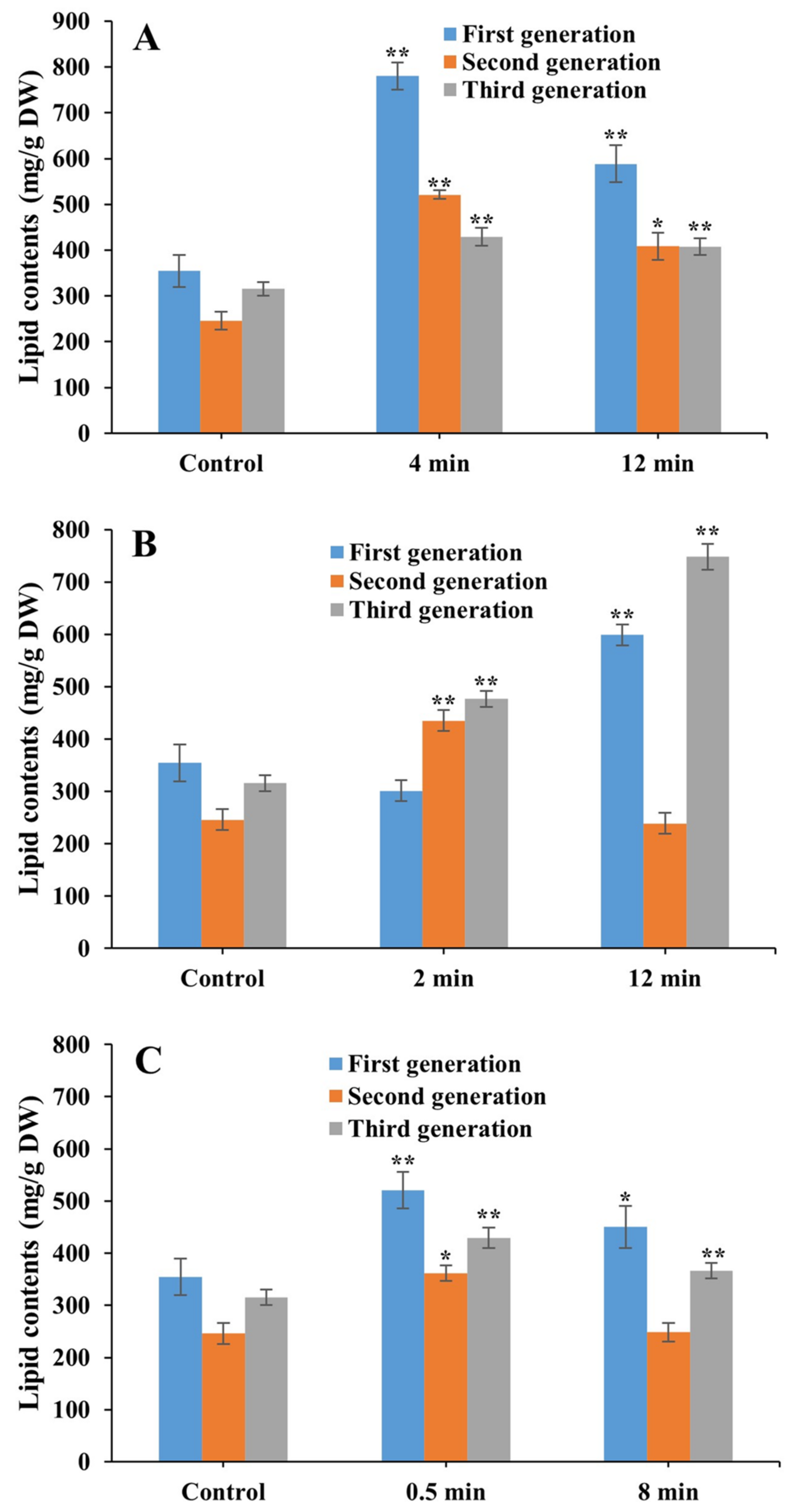
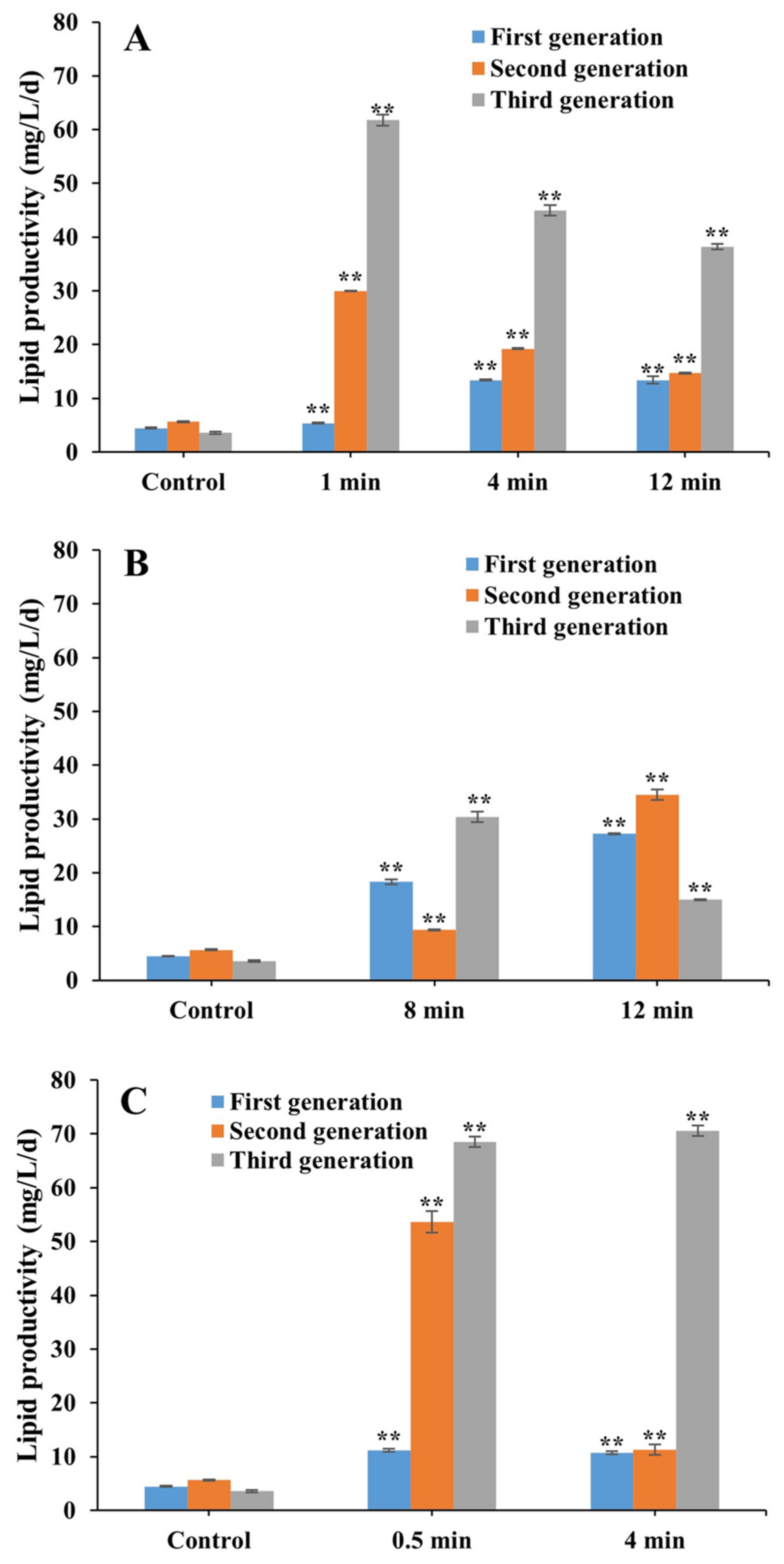
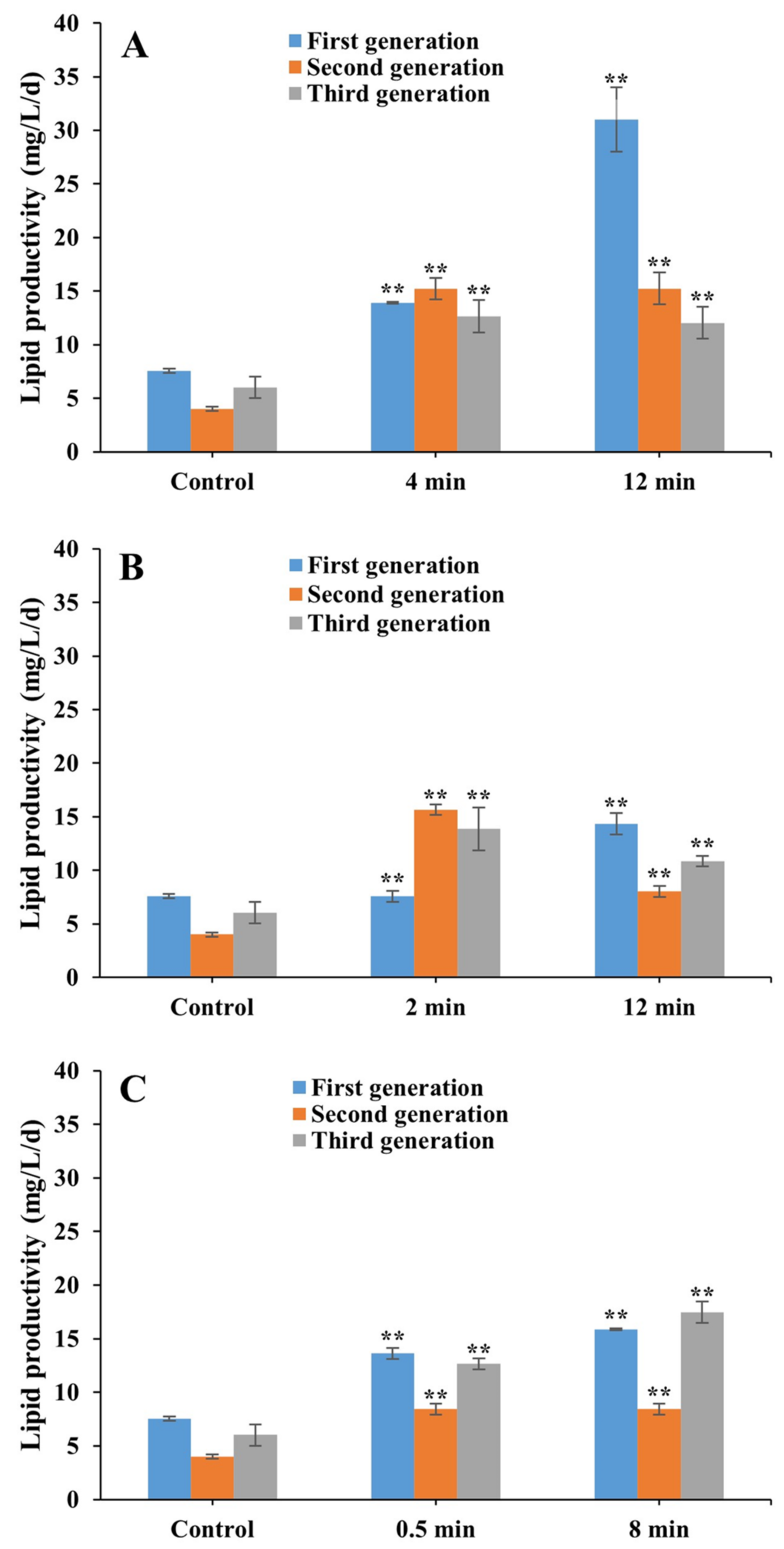
| Chemical Component | Original BG11 Medium (g/L) | Modified BG11 Medium (g/L) |
|---|---|---|
| NaNO3 | 1.5 | 7.5 |
| K2HPO4 | 0.04 | 0.2 |
| MgSO4•7H2O | 0.075 | 0.375 |
| Na2CO3 | 0.02 | 0.1 |
| Citric acid | 0.006 | 0.03 |
| CaCl2•2H2O | 0.036 | 1.8 |
| Ferric ammonium citrate | 0.006 | 0.03 |
| EDTANa2 50 mg, | 0.001 | 0.005 |
| H3BO3 2.86 g, | 2.86 | 2.86 |
| MnCl2•4H2O 1.86 g, | 1.81 | 1.86 |
| ZnSO4•7H2O 0.22 g, | 0.22 | 0.22 |
| CuSO4•5H2O 80 mg, | 0.079 | 0.08 |
| Na2MoO4•2H2O 0.39 g, | 0.39 | 0.39 |
| Co(NO3)2•6H2O 50 mg, | 0.049 | 0.05 |
| pH value | 7.5 adjusted using 1 M HCl | 7.10 adjusted using 1 M HCl |
| Algal Strain | C4:0 | C6:0 | C8:0 | C10:0 | C17:0 | C18:2 | C20:0 | C20:2 | LNA | CLA | γ-LNA | Others |
|---|---|---|---|---|---|---|---|---|---|---|---|---|
| control | 8.02 ± 0.24 | 3.13 ± 0.12 | – | – | – | – | 19.12 ± 2.24 | – | 1.17 ± 0.09 | – | – | 68.56 ± 4.42 |
| He–Ne 1 min | 8.26 ± 0.51 | 5.24 ± 0.45 | 11.45 ± 0.45 | – | 16.36 ± 1.34 | 16.34 ± 1.22 | – | 6.04 ± 1.11 | – | 8.22 ± 0.53 | 11.16 ± 0.56 | 16.93 ± 1.12 |
| He–Ne 4 min | 8.46 ± 0.11 | 5.56 ± 0.22 | 11.12 ± 1.22 | 4.13 ± 0.23 | 16.11 ± 0.22 | 16.11 ± 0.78 | – | 6.12 ± 0.34 | – | 8.13 ± 0.67 | 11.78 ± 1.21 | 12.48 ± 0.97 |
| He–Ne 1 2min | 8.33 ± 0.29 | 5.06 ± 087 | 9.08 ± 0.76 | 6.23 ± 0.56 | 5.48 ± 0.11 | – | – | 4.33 ± 0.11 | – | - | 7.03 ± 0.97 | 54.46 ± 3.11 |
| Nd:YAG 8 min | 8.21 ± 0.36 | 5.11 ± 0.43 | 11.77 ± 0.97 | – | 16.97 ± 0.56 | 16.89 ± 2.01 | – | 6.78 ± 0.45 | – | 8.78 ± 0.77 | 11.57 ± 1.15 | 13.92 ± 0.77 |
| Nd:YAG 12 min | 8.57 ± 0.44 | 5.29 ± 025 | 11.07 ± 0.48 | 1.04 ± 0.11 | 16.13 ± 0.89 | – | 19.45 ± 0.27 | 6.07 ± 0.34 | – | 8.82 ± 0.11 | 11.21 ± 0.43 | 12.35 ± 0.33 |
| SC 0.5 min | 8.87 ± 0.34 | 6.87 ± 0.77 | 1.22 ± 0.12 | – | – | 13.02 ± 0.97 | – | 3.11 ± 0.26 | – | 4.16 ± 0.45 | 6.23 ± 0.15 | 56.52 ± 2.96 |
| SC 4 min | 8.32 ± 0.16 | 5.75 ± 0.14 | 11.61 ± 0.23 | 5.11 ± 0.33 | 7.16 ± 0.14 | 14.11 ± 0.34 | – | 3.56 ± 0.13 | – | – | – | 44.38 ± 1.14 |
| Algal Strain | C4:0 | C6:0 | C8:0 | C11:0 | C17:0 | LNA | Others |
|---|---|---|---|---|---|---|---|
| control | 8.11 ± 0.72 | 3.11 ± 0.45 | – | – | 1.23 ± 0.21 | – | 87.55 ± 3.41 |
| He–Ne 4 min | 8.45 ± 0.11 | 5.06 ± 0.23 | 5.12 ± 0.32 | – | 2.11 ± 0.16 | 1.45 ± 0.14 | 77.81 ± 4.13 |
| He–Ne 12 min | 8.23 ± 0.98 | 6.09 ± 0.62 | 4.06 ± 0.21 | – | 4.45 ± 0.32 | 2.36 ± 0.12 | 74.81 ± 2.18 |
| Nd:YAG 2 min | 8.04 ± 1.12 | 5.56 ± 0.23 | 3.32 ± 0.18 | 1.12 ± 0.14 | 5.78 ± 0.45 | 2.21 ± 0.11 | 73.97 ± 5.23 |
| Nd:YAG 12 min | 8.68 ± 0.76 | 6.23 ± 0.45 | 3.11 ± 0.25 | 1.06 ± 0.11 | 5.04 ± 0.31 | 1.67 ± 0.21 | 74.21 ± 3.35 |
| SC 0.5 min | 8.15 ± 1.14 | 6.14 ± 0.36 | 3.03 ± 0.11 | 1.75 ± 0.11 | 5.15 ± 0.37 | 2.89 ± 0.19 | 72.89 ± 2.98 |
| SC 8 min | 8.98 ± 2.21 | 5.42 ± 0.41 | 3.45 ± 0.32 | – | 3.14 ± 0.19 | 2.37 ± 0.21 | 76.64 ± 3.23 |
Publisher’s Note: MDPI stays neutral with regard to jurisdictional claims in published maps and institutional affiliations. |
© 2021 by the authors. Licensee MDPI, Basel, Switzerland. This article is an open access article distributed under the terms and conditions of the Creative Commons Attribution (CC BY) license (https://creativecommons.org/licenses/by/4.0/).
Share and Cite
Xing, W.; Zhang, R.; Shao, Q.; Meng, C.; Wang, X.; Wei, Z.; Sun, F.; Wang, C.; Cao, K.; Zhu, B.; et al. Effects of Laser Mutagenesis on Microalgae Production and Lipid Accumulation in Two Economically Important Fresh Chlorella Strains under Heterotrophic Conditions. Agronomy 2021, 11, 961. https://doi.org/10.3390/agronomy11050961
Xing W, Zhang R, Shao Q, Meng C, Wang X, Wei Z, Sun F, Wang C, Cao K, Zhu B, et al. Effects of Laser Mutagenesis on Microalgae Production and Lipid Accumulation in Two Economically Important Fresh Chlorella Strains under Heterotrophic Conditions. Agronomy. 2021; 11(5):961. https://doi.org/10.3390/agronomy11050961
Chicago/Turabian StyleXing, Wei, Ruihao Zhang, Qun Shao, Chunxiao Meng, Xiaodong Wang, Zuoxi Wei, Fengjie Sun, Chang Wang, Kai Cao, Bingkui Zhu, and et al. 2021. "Effects of Laser Mutagenesis on Microalgae Production and Lipid Accumulation in Two Economically Important Fresh Chlorella Strains under Heterotrophic Conditions" Agronomy 11, no. 5: 961. https://doi.org/10.3390/agronomy11050961
APA StyleXing, W., Zhang, R., Shao, Q., Meng, C., Wang, X., Wei, Z., Sun, F., Wang, C., Cao, K., Zhu, B., & Gao, Z. (2021). Effects of Laser Mutagenesis on Microalgae Production and Lipid Accumulation in Two Economically Important Fresh Chlorella Strains under Heterotrophic Conditions. Agronomy, 11(5), 961. https://doi.org/10.3390/agronomy11050961






